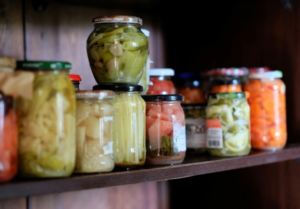
You know how there’s always that one person that’s annyoing AF to be around? The one you never want at your party, yet there they are. Every. Single. Time.
For me, it was my neighbor Anita. She was so annoying that her family “lovingly” called her Anita PITA, as in Pain. In. The. Ass… because she was (is?) the most whiny and helpless grown-ass woman I’ve ever met. You do not want Anita at your party.
You know who else you don’t want at your party? H. pylori. This party is not just some block party though, this is your gut party, and H. pylori just loves to come over uninvited, just like Anita.
Here’s why you care…
H. pylori is a Screwball
H. pylori is corkscrew-shaped and screws itself into the mucus layer of the stomach lining and duodenum and then… it multiplies like rabbits.
This bacteria secretes an enzyme called urease that converts urea to ammonia… and this ammonia protects H. pylori from stomach acid by actually increasing the pH of your gut so that it’s less acidic. Since this acidity is beneficial in keeping harmful pathogens at bay, we want that acid to stay… acidic.
As H. pylori multiplies, it eats into stomach tissue, which leads to gastritis and/or peptic ulcers. No bueno.
The Symptoms Suck
Sometimes, symptoms can seem general, until you look at them as a group, and then it’s clear to see when H. pylori might be a problem.
Some Common Symptoms
- dull or burning pain in your stomach (more often a few hours after eating and at night)
- unplanned weight gain (or loss)
- bloating, so much bloating people ask when your baby is due
- feeling full after eating a few bites of your meal
- nausea/vomiting, the double whammy
- indigestion
- reflux, ohhhh, the burning
- constipation
- burping
- loss of appetite
- dark stools (from blood in stool, typically when infection is more advanced)
- metabolic disorders such as type 2 diabetes
Sounds like a dream, right? But guess what?
Many Negative Tests are Actually… Not
About half of my clients’ GI-MAP gut health tests show elevated levels of H. pylori.
Why is this?
It’s because it is SUPER common… about half of the world’s population carries H. pylori AND it’s very common for all members in a household to carry it since H. pylori bacteria are easily passed from person to person through direct contact with saliva, vomit or stool.
Note: If you treat H. pylori but your husband doesn’t and he carries it, guess who’s getting H. pylori again? Yep, you. This is sometimes why people think their treatment didn’t work… because old hubs gave you his H. pylori right after you killed yours.
So… yeah.
Here’s the interesting thing: some people will develop symptoms and some won’t. Scientists do not understand why this is.
It’s a Sneaky Little Devil
I have a number of clients that had H. pylori tests prior to coming to me, and whether that was a breath test, stool analysis, or blood test, their H. pylori test was negative, and thus was ruled out as the issue.
But get this… H. pylori, when it’s hiding in your stomach lining, can evade testing. Your best chance of it showing up on your test is when you’re using a test that gives the actual count of the bacteria in your gut rather than a positive/negative result.
Let’s take a deeper dive.
So, there are two types of testing technology, PCR and qPCR.
PCR, or polymerase chain reaction, is a common lab technique used in some stool testing, as well as other testing (remember COVID tests, those were PCR technology). The result from a PCR test is a positive or negative. Yes, you have H. pylori present (or COVID) or no, you do not. The problem with this technology when attempting to detect a pathogen or bacteria is… there is a cut off point for making the determination of a positive or negative test, and it’s not zero.
So, what happens is this… Say they’re testing for H. pylori with a PCR test. And say the level to be flagged is 1000 CFU/g (colony forming units per gram of stool – this is actually the number at which you’d be flagged as HIGH on some tests.).
OK, so you have 765 CFU/g of H. pylori… your test result using PCR technology is negative, despite the fact that you DO have H. pylori present, but the 765 is below the cutoff for the test to flag you as positive.
Does that H. pylori need to be treated? Maybe it does, it would depend on your symptoms, but wouldn’t you like to know it’s there?
As for the other testing technology, qPCR, it’s quantitative PCR, meaning it gives the actual number of bacteria, parasites, pathogens, etc. that are detected as your result for each measured microbe. This is the technology used on the GI-MAP gut health test, and this is why I test all my clients, first thing, with this test… there is no better analysis of your gut situation.
So, to continue the example above, if you have 765 CFU/g of stool, your test result would be… 765 CFU/g. qPCR tests don’t try to decipher the result for you. qPCR tests don’t provide a negative result when a specific bacteria is actually present. You just get the actual number that are present when testing for the DNA of the microbe (yeah, it does a DNA test to determine the shit in your gut!).
Long ass way of saying, if you have the symptoms of H. pylori, but have a negative PCR test result, don’t count that sneaky mofo out just yet. H. pylori is persistent and can be in your gut for years, and I mean 10, 20, 30, or more.
The Silver Lining
The good news? There are treatments to get rid of it… not at all like Anita… she just lingers.
If you’re dealing with these symptoms, let’s take a peek at what’s going on in your gut. Simple to test. You could be healing your gut in a couple of weeks. Don’t wait!
Need some support with your gut health? Maybe you’re not quite sure what you want to do yet, but you do want to ask questions… book your FREE gut assessment today. I’d love to chat and see how I can help you heal your gut NOW!











